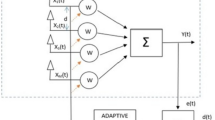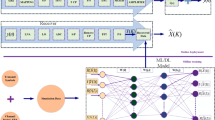Abstract
To reduce the peak-to-average power ratio (PAPR) in the orthogonal frequency division multiplexing (OFDM) transmission technique, several reduction approaches have been used. Among these is the selective mapping (SLM) scheme, and while having been highly adopted, its considerable computational complexity for optimum phase factors search is challenging for practical systems. To overcome this issue with SLM while still reducing the PAPR, a variety of optimization algorithms have been applied for optimal phase factors search. Limitations in all these algorithms include the need for specific parameters for peak performance and a decrease in effectiveness for complicated problems that have a significant number of variables. In this work, a novel optimization algorithm, called teaching-learning–based optimization (TLBO), featuring less computational effort and no algorithm-specific parameter requirement, is applied to reduce the PAPR of the OFDM signal. MATLAB simulation results demonstrate that the proposed TLBO-SLM method efficiently performs better than conventional SLM and previously applied optimization algorithms.







Similar content being viewed by others
References
Rahmatallah Y, Mohan S (2013) Peak-to-average power ratio reduction in OFDM systems: a survey and taxonomy. IEEE Commun Surveys Tuts 15:1567–1592
Shokair M, Sakran H (2012) Performance of SDM COFDM system in the presence of nonlinear power amplifier. Telecommun Syst 50:89–95
Bo A, Yang Z, Pan C, Zhang T, Ge J (2005) Effects of PAPR reduction on HPA predistortion. IEEE Trans Consum Electron 51:1143–1147
Park D H, Song H K (2007) A new PAPR reduction technique of OFDM system with nonlinear high power amplifier. IEEE Trans Consumer Electronics 53:327–332
Zhu X, Pan W, Li H, Tang T. (2013) Simplified approach to optimized iterative clipping and filtering for PAPR reduction of OFDM signals. IEEE Trans Commun 61:1891–1901
Moo B, Kim L Y, An Adaptive Clipping (2013) filtering technique for PAPR reduction of OFDM signals circuit. Syst, and Signal Process 32:1335–1349
Joshi A, Saini DS (2017) GA-PTS Using novel mapping scheme for PAPR reduction of OFDM signals without SI. Wirel Pers Commun 92:639–651
Weng C E, Chang C W, Chen C H, Hung H L (2012) Novel low-complexity partial transmit sequences scheme for PAPR reduction in OFDM systems using adaptive differential evolution algorithm. Wirel Pers Commun 71:679–694
Louliej A, Jabrane Y, Said BAE, Ouahman A (2013) Peak to average power ratio reduction in ECMA-368 ultra wideband communication systems using active constellation extension. Wirel Pers Commun 70:667–694
Sundeepkumar V, Anuradha S (2016) Adaptiveclipping-based active constellation extension for PAPR reduction of OFDM OQAM signals. Circuits Syst and Signal Process 36:3034–3046
Gazor S, Hemmati RA (2012) Tone reservation for OFDM systems by maximizing signal-to-distortion ratio. IEEE Trans Wireless Commun 11:762–770
Li H, Jiang T, Zhou Y (2011) An improved tone reservation scheme with fast convergence for PAPR reduction in OFDM systems. IEEE Trans Broadcast 57:902–906
Chen J C, Wen C K (2010) PAPR reduction of OFDM signals using cross-entropy-based tone injection schemes. IEEE Signal Process Lett 17:727–730
Jacklin N, Zhi D (2013) A linear programming based tone injection algorithm for PAPR reduction of OFDM and linearly precoded. IEEE Trans Circuits and Systems 60:1937–1945
Taher MMA, Singh MJ, Ismail M, Samad SA, Islam MT, Mahdi HF (2015) Post-IFFT-modified selected mapping to reduce the PAPR of an OFDM system. Circuits Syst and Signal Process 34:535–555
Moshiur M, Bhuiyan NA, Rahim MS, Ahmed S (2016) A computationally efficient selected mapping technique for reducing PAPR of OFDM. Telecommun Syst 65:637–647
Falahati A, Anarakifirooz E (2019) Weighted sum rate maximization under the given PAPR constraints for a multi-user OFDM system. Wireless Personal Communication 109:127–137
Wen JH, Lee SH, Huang YF, Hung HL (2008) A sub-optimalPTS algorithm based on particle swarm optimization technique for PAPR reduction in OFDM Systems. EURASIP J. Wireless Commun Netw 2008:1–8
Fathy AS, Mohammed SE, Essam AAH (2015) SLM technique based on particle swarm optimization algorithm for PAPR reduction in wavelet-OFDM systems. In: 32nd National Radio Science Conference (NRSC), pp 163–170
Taspinar N, Yildirim M (2015) A novel parallel artificial bee colony algorithm and its PAPR reduction performance using SLM scheme in OFDM and MIMO-OFDM systems. IEEE Communications Letters 19:1830–1833
Taspinar N, Karaboga D, Yildirim M, Akay B (2011) Partial transmit sequences based on artificial bee colony algorithm for peak-to-average power ratio reduction in multicarrier code division multiple access systems. IET Commun 5:1155–1162
Nguyen T, Lampe L (2008) PAPR Reduction of OFDM signals using partial transmit sequences with low computational complexity. IEEE Trans Wireless Commun 7:746–755
Jiang T, Xiang W, Richardson PC, Guo J, Zhu G (2007) PAPR reduction of OFDM signals using partial transmit sequences with low computational complexity. IEEE Trans Broadcast 53:719– 724
Tan LT, Hu RQ, Hanzo L (2019) Heterogeneous networks relying on full-duplex relays and mobility-aware probabilistic caching. IEEE Transactions on Communications 67:5037–5052
Tan LT, Hu RQ, Hanzo L (2019) Twin-timescale artificial intelligence aided mobility-aware edge caching and computing in vehicular networks. IEEE Transactions on Vehicular Technology Special issue on Fog/Edge Computing for Autonomous and Connected Cars 68:3086–3099
Rao RV, Savsani VJ, Vakharia DP (2011) Teaching-learning-based optimization: a novel method for constrained mechanical design optimization problems. Comput -Aided De 43:303–315
Rao RV (2016) Teaching learning based optimization algorithm and its engineering applications springer international publishing
Ji J, Ren G (2013) A new modified SLM scheme for wireless OFDM systems without side information. IEEE Signal Processing Letters 20:1090–1093
Chen JC (2010) Partial transmit sequences for PAPR reduction of OFDM signals with stochastic optimization techniques. IEEE Transactions on Consumer Electronics 56:1229–1234
Author information
Authors and Affiliations
Corresponding author
Additional information
Publisher’s note
Springer Nature remains neutral with regard to jurisdictional claims in published maps and institutional affiliations.
Rights and permissions
About this article
Cite this article
HADJ ALI, T., HAMZA, A. Low-complexity PAPR reduction method based on the TLBO algorithm for an OFDM signal. Ann. Telecommun. 76, 19–26 (2021). https://doi.org/10.1007/s12243-020-00777-0
Received:
Accepted:
Published:
Issue Date:
DOI: https://doi.org/10.1007/s12243-020-00777-0




